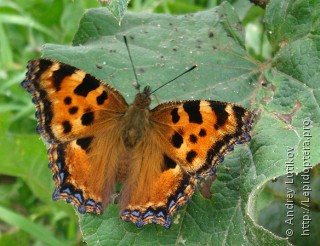Nymphalis polychloros
Taxonomy
class Insecta
Species name(s)
Nymphalis polychloros (Linnaeus, 1758) = Vanessa polychloros = Papilio polychloros Linnaeus, 1758 = Papilio testudo Esper, 1781 = pyrrhomelaena Hübner, [1824] = Vanessa pyromelas Freyer, [1834] = Vanessa dixeyi Standfuss, 1895 = polychloros fervida Standfuss, 1896 = Vanessa polychloros lucida Fruhstorfer, 1907 = Vanessa polychloros dilucidus Fruhstorfer, 1907 = Vanessa cassabiensis Heinrich, 1910 = Nymphalis binaria Eisner 1966 = Nymphalis concolor Lempke 1956 = Vanessa circumpunctata Cabeau, 1926 = Vanessa dixeyi Standfuss, 1896 = Vanessa erythromelas Austaut, 1885 = Vanessa extincta Gönner, 1928 = Vanessa extrema Gönner, 1928 = Nymphalis flavomaculata Lempke 1956 = Eugonia pallida Tutt, 1896 = Nymphalis parvipuncta Lempke 1956 = Nymphalis longipuncta Lempke 1956 = Nymphalis magnipuncta Lempke 1956 = Vanessa orichalcea Bois-Reymond, 1931 = Vanessa nigroflava Biezanko, 1924 = Nymphalis nubilata Lempke 1956 = Nymphalis postnigrescens Lempke 1956 = Vanessa punctata Bois-Reymond, 1931 = Vanessa pyromelas Freyer, 1830 = Vanessa pyrrhomelaena Hübner, 1826-1828 = Eugonia quinquepunctata Raynor, 1906 = Vanessa supinskia Wise, 1936 = Vanessa testudo Esper, 1782 = Nymphalis vigens Lempke 1956 = Vanessa xanthochloros de Villiers & Guenée, 1835. [9, 10, 85, 187]
Large Tortoiseshell.
urn:lsid:insecta.pro:taxonomy:8614
Expansion
This species marks on the maps: 1.
Zoogeographical regions
Palaearctic.
Russia regions
#1. Kaliningradsky; #3. Karelsky; #4. Evropeisky Severo-Zapadny; #7. Evropeisky yuzhno-tayozhny; #8. Evropeisky Tsentralny; #9. Evropeisky Tsentralno-Chernozyomny; #10. Sredne-Volzhsky; #11. Volgo-Donsky; #12. Nizhnevolzhsky; #13. Zapadno-Kavkazsky; #14. Vostochno-Kavkazsky; #16. Sredne-Uralsky; #17. Yuzhno-Uralsky.
Forewing length
27—30 mm.
Primary colors
Orange, Brown/Gray/Black.
Flight time
| January | February | March | April | May | June | July | August | September | October | November | December |
Larva lifespan
| January | February | March | April | May | June | July | August | September | October | November | December |
Over-wintering stage
Imago.
Detailed information with references
Taxonomy, synonyms and combinations
Distribution
Imago Habitus and Differences from alike species
General info about Imago
Imago lifespan
General info about Larva
Larva food plants / other food objects
Larva lifespan
Pupa
Egg
Overwintering stage
Subspecies of Nymphalis polychloros
- Nymphalis polychloros dilucidus Fruhstorfer, 1907. [187]
- N. p. erythromelas (Austaut, 1885). [9]
- N. p. fervida Standfuss. [187]
- N. p. polychloros. [9]
Authors
Initial species uploading to the site: Peter Khramov.
Text data: Peter Khramov.
The species characteristics formalization: Peter Khramov, Sergei Kotov.
References
- [3] Каталог чешуекрылых (Lepidoptera) России. Под ред. С. Ю. Синёва. СПб.; М.: Товарищество научных изданий КМК, 2008
- [9] Tree of Life (funet.fi), 2012
- [10] de Jong, Y.S.D.M. (ed.) (2011) Fauna Europaea version 2.4 (faunaeur.org)
- [28] Moths and Butterflies of Europe and North Africa (leps.it), 2012
- [85] Lepidoptera species catalogue, Lepidoptera.ru, 2015
- [187] Species 2000, http://www.sp2000.org
Comments
Note: you should have a Insecta.pro account to upload new topics and comments. Please, create an account or log in to add comments
Nymphalis polychloros photos




















All the photos of the species in large size
Please, create an account or log in to upload your photo










